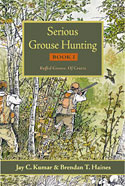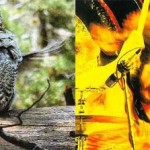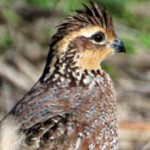Ever See These Parasites Before?
When we were in Minnesota last year, we heard tell of a worm-like parasite that was suspected to have been bringing down the grouse population. Never saw it ourselves – probably didn’t kill enough birds (lol) – but recently a compadre of ours sent us these photos of parasitic worms he found in his first grouse of the year.
Nasty, eh?
Anyone ever seen these before?
Since our buddy Dan lives in Minnesota, we contacted Ted Dick, MN DNR’s grouse biologist, and asked him if he could ID the worm. He could: It’s called Ascaridia bonasae. That last piece of Latin should be familiar to ruffie hunters because the taxonomic name of the wily furry forest chicken is: Bonasa umbellus.
[Btw: Bonasa means “good when roasted” and umbellus is “sunshade,” aka umbrella, meaning the male’s ruff. Sort of a crime the bird isn’t named after Superman or something else that can dodge “bullets.”]
A little more on the parasite, from this website:
> Ascaridia bonasae is a large, whitish nematode normally located in the small intestine of ruffed grouse. Hunters may find this roundworm in the body cavity when it escapes through holes in the small intestine created by pellets of shot.
> The life cycle of A. bonasae is direct, i.e., no intermediate host is necessary. Eggs are laid by adult female worms in the intestine of the host and are eliminated with the droppings. These eggs are in turn picked up by susceptible birds in feed and water.
> Adult female worms measure up to about 50 mm and males to approximately 35 mm in length. There are usually only a few worms present in each grouse although more than 75 worms have been reported from a single bird.
> Dorney and Kabat (1960) reported that the extent of infection of young grouse with A. bonasae during the summer is directly related to the abundance of grouse during the latter months of the previous winter.
> A. bonasae is not considered a serious pathogen of ruffed grouse and does not affect the edibility of the birds.
In other words:
> These parasites are normal, and elsewhere it says these things can be found throughout the grouse range.
> These things apparently don’t take up residence in people, should you have the misfortune to eat one.
We found the reference to the 1960 study interesting, tracked down and found these tidbits from it:
> Parasitic disease was density-related since the abundance of grouse in late winter was found to be directly related to the extent of infection with Ascaridia bonasae in young birds the following summer. [In other words, more birds = more infected birds.]
> During [peak population] years, the incidence of parasitic disease is higher, overwinter losses and brood mortality are increased….
In view of the second bullet, the scientists recommended (for northern WI) an “experimental overharvest of high [grouse] populations in the north [with] hunting season starting in mid-September and with removal of the bag limit – along with “an experimental spring hunting season…similar to the spring hunting of tetraonid cocks in Europe.”
More:
A spring hunt should be restricted to the last three weeks in May. It would be biologically feasible for the following reasons:
1. A current low fall harvest of adult males in the north is evident.
2. A reservoir of nonterritorial cocks is able to replace lost males.
3. Areas having low population densities would be made huntable in spring since the cock drumming behavior pin-points the quarry.
4. Few hens are seen once incubation has started, almost eliminating the likelihood of their being shot, especially with hunting activity centering around drumming logs.
5. There is an apparently low inclination of ruffed grouse to renest, hence there is a decreased importance of the cock in the last three weeks of May.
Such a season could provide a million recreational hours annually to hunters in northern Wisconsin. The sporting qualities of such a hunt are high, judging by its widespread acceptance in Europe.
Bowhunting for drumming cocks might be more acceptable to the general public and reduce accidental hen losses.
Pretty funny, eh? Although bird hunting in the spring sounds would mean half the wait each year….
Category: Disease, MN, Ruffed Grouse, WI




















we have come across these parasites in the northerh part of MN. more so then the southern part of MN. grouse range. It was during the peak of the cycle. Tom
Haven’t seen these in awhile with the low grouse numbers in Ohio. Back in the late ’80s a friend shot a grouse that was acting funny and hesitant to fly. When he opened it up the entire body cavity was a writhing mass of those worms. Back then we were young and didn’t realize intestinal worms in grouse, or warbles on squirrels and rabbits, don’t affect the meat. We discarded the bird.
We saw some of these in birds last year. The meat was clean and they were only in the body cavity in the gut. Birds tasted great and I am still alive so no worries.
I killed a bird in Itasca County MN 10/19/2011 had one of these worms in the gut.
Got a ruffy yesterday affected by Ascaridia bonasae in Atkin area (MN 5631)
People,
do research? parasites are everywhere even in our body. is it Safe to eat bird with parasites? i don’t know! i am assuming. Even Fish have them. Its identify that fish came from Fresh water..use Salt and freeze to kill them.
I found 2 of these worms in the breast meat of a late dec. Grouse I shot about 3 yrs. ago, I shot another late dec. bird last week 12/26/12 and found another worm on top of the breast under the skin when cleaning it. I read it could be due to over population , I can assure you this is not the case in northern Wisconsin where I live and hunt the grouse pop. has been down for several years. Any other causes or info.?
A co worker of mine had told me he had found a worm looking thing in the gut cavity of some ruff grouse he had got the weekend before and asked me if I had ever seen this. I told him I hadn’t noticed anything like that before. I got some ruffs this past weekend and thought about what he had said when I was cleaning them. Sure enough I found one and it looks exactly like the picture above. Is this normal and safe to eat the meat?
Yeah im from northern new brunswick, ive been finding 1-2birds a year with those worms, most people that say have never seen em is cuz of the way they clean em they step on the wings and the guts stay on the ground, i usualy find the worm in the guts. But one time i cleaned one and put it in the fridge and then found the worm in the plate the next day!
Shot a partridge/grouse in Algoma district of central Ontario Canada during the small game season October 2017. . After 40 years of hunting big game and partridge/grouse this was the first time while gutting the bird found two of the worms in the chest cavity.